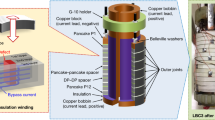Abstract
A cryogen-free hybrid magnet without liquid helium for operation, generating 27.5 T in a 32 mm room temperature bore of an 8 MW water-cooled resistive insert magnet in an 8.5 T background field of a cryogen-free superconducting outsert magnet, is being operated for basic research at low temperatures down to 17 mK in combination with a dilution refrigerator. In addition, we are developing functional materials using a differential thermal analysis DTA at high temperatures up to 1473 K in high fields up to 27 T. This cryogen-free hybrid magnet will be upgraded to generate 29 T by improving the outer superconducting magnet.
A cryogen-free 18.1 T superconducting magnet with a 52 mm room temperature experimental bore, consisting of a Bi2Sr2Ca2Cu3O10 (Bi2223) insert coil, has been developed using a GM-JT cryocooler. Recently, bronze-tape-laminated Bi2223 has revealed excellent irreversible stress tolerance of 250 MPa at 77 K. In addition, the critical current properties for recent Bi2223 tapes are largely improved from 200 to 400 A/cm-width at 77 K in a self-field. Therefore, the stainless steel reinforcement tape incorporated for the previous Bi2223 insert coil is no longer needed for a new Bi2223 one. A new Bi2223 insert coil with almost the same size as the existing insert coil can generate two times higher fields at the elevated operation current from 162 to 191 A. An upgraded cryogen-free superconducting magnet can offer a long-term experiment at the constant magnetic field of 20 T for an in-field heat-treatment investigation.







Similar content being viewed by others
References
K. Watanabe, Y. Yamada, J. Sakuraba, F. Hata, C.K. Chong, T. Hasebe, M. Ishihara, Jpn. J. Appl. Phys. 32, L488 (1993)
G. Nishijima et al., Fusion Eng. Des. 81, 2425 (2004)
K. Watanabe, S. Awaji, G. Nishijima, S. Hanai, M. Ono, Appl. Phys. Express 2, 113001 (2009)
K. Watanabe, G. Nishijima, S. Awaji, K. Takahashi, K. Koyama, N. Kobayashi, M. Ishizuka, T. Itou, T. Tsurudome, J. Sakuraba, IEEE Trans. Appl. Supercond. 16, 934 (2006)
M. Ishizuka, T. Hamajima, T. Itou, J. Sakuraba, G. Nishijima, S. Awaji, K. Watanabe, Physica C 470, S1027 (2010)
M. Sagawa, S. Fujimura, H. Yamamoto, Y. Matsuura, K. Hiraga, IEEE Trans. Magn. MAG-20, 1584 (1984)
X. Guo, X. Chen, Z. Altounian, J.O. Ström-Olsen, J. Appl. Phys. 73, 6275 (1993)
Y. Mitsui et al., Mater. Trans. (2012) submitted
K. Koyama et al., J. Alloys Compd. 509, L78 (2011)
Y. Kozuka et al., Phys. Rev. B 84, 033304 (2011)
Acknowledgements
Authors acknowledge Furukawa Electric Co., Ltd., Fujikura Ltd., Toshiba Corporation, and Sumitomo Heavy Industries Ltd. for the collaboration on the HTS and LTS wires, the HTS conductors, the 18 T cryogen-free superconducting magnet and its upgrading, and the 28 T cryogen-free hybrid magnet, respectively. The high field studies of the MnBi phase diagram were mainly performed by Yoshifuru Mitusui at the HFLSM. We also thank for his cooperations.
Author information
Authors and Affiliations
Corresponding author
Rights and permissions
About this article
Cite this article
Watanabe, K., Awaji, S. & Oguro, H. Wide Variety of Experiments Using a Cryogen-Free 27.5 T Hybrid Magnet and a Cryogen-Free 18.1 T Superconducting Magnet. J Low Temp Phys 170, 503–510 (2013). https://doi.org/10.1007/s10909-012-0694-4
Received:
Accepted:
Published:
Issue Date:
DOI: https://doi.org/10.1007/s10909-012-0694-4




